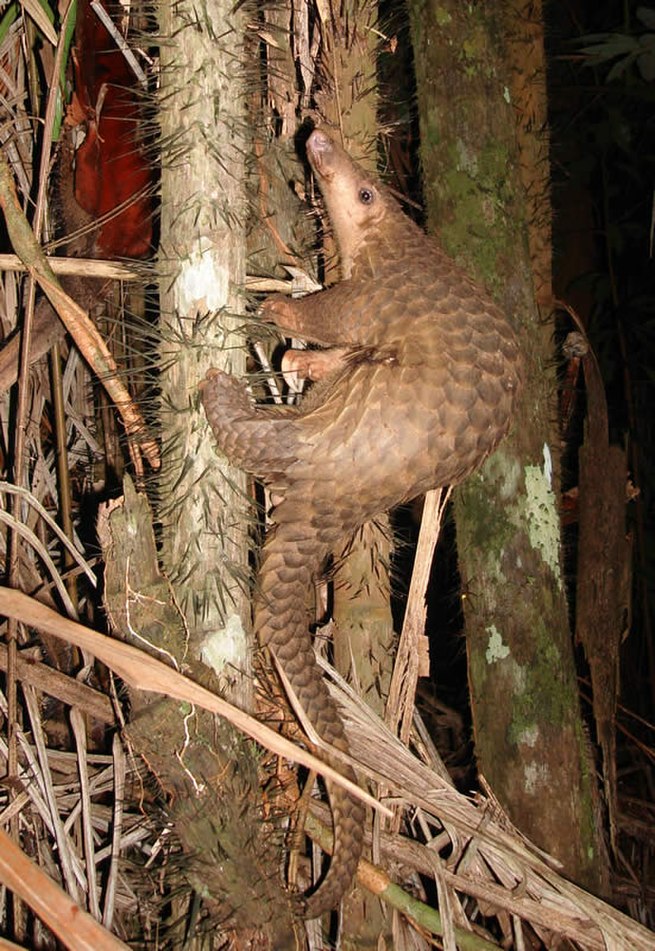Main Difference
The main difference between Pangolin and Armadillo is that the Pangolin is a order of mammals and Armadillo is a family of mammals.
-
Pangolin
Pangolins are mammals of the order Pholidota. The one extant family, Manidae, has three genera: Manis, which comprises four species living in Asia; Phataginus, which comprises two species living in Africa; and Smutsia, which comprises two species also living in Africa. These species range in size from 30 to 100 cm (12 to 39 in). A number of extinct pangolin species are also known.
Pangolins have large, protective keratin scales covering their skin, and they are the only known mammals with this feature. They live in hollow trees or burrows, depending on the species. Pangolins are nocturnal, and their diet consists of mainly ants and termites which they capture using their long tongues. They tend to be solitary animals, meeting only to mate and produce a litter of one to three offspring which are raised for about two years. Pangolins are threatened by hunting (for their meat and scales) and heavy deforestation of their natural habitats, and are the most trafficked mammals in the world. Of the eight species of pangolin, four (Phataginus tetradactyla, P. tricuspis, Smutsia gigantea, and S. temminckii) are listed as vulnerable, two (Manis crassicaudata and M. culionensis) are listed as endangered, and two (M. pentadactyla and M. javanica) are listed as critically endangered on the International Union for Conservation of Nature Red List of Threatened Species.
-
Armadillo
Armadillos are New World placental mammals in the order Cingulata with a leathery armour shell. The Chlamyphoridae and Dasypodidae are the only surviving families in the order, which is part of the superorder Xenarthra, along with the anteaters and sloths. The word armadillo means “little armoured one” in Spanish. The Aztecs called them āyōtōchtli [aːjoːˈtoːt͡ʃt͡ɬi], Nahuatl for “turtle-rabbit”: āyōtl [ˈaːjoːt͡ɬ] (turtle) and tōchtli [ˈtoːt͡ʃt͡ɬi] (rabbit). The Portuguese word for “armadillo” is tatu which derives from the Tupi language. Similar names are also found in other, especially European, languages.
About nine extant genera and 21 extant species of armadillo have been described, some of which are distinguished by the number of bands on their armour. Their average length is about 75 cm (30 in), including tail. The giant armadillo grows up to 150 cm (59 in) and weighs up to 54 kg (119 lb), while the pink fairy armadillo is a diminutive species, with an overall length of 13–15 cm (5–6 in). All species are native to the Americas, where they inhabit a variety of different environments.
Recent genetic research suggests that an extinct group of giant armoured mammals, the glyptodonts, should be included within the lineage of armadillos, having diverged some 35 million years ago, much more recently than previously assumed.
-
Pangolin (noun)
The scaly anteater; any of several long-tailed, scale-covered mammals of the order Pholidota of tropical Africa and Asia, the sole extant genus of which is Manis.
“trenggiling|scaly anteater”
-
Armadillo (noun)
Any of the burrowing mammals covered with bony, jointed, protective plates, order Cingulata, found in the Americas, especially in South America.
-
Pangolin (noun)
an African and Asian mammal that has a body covered with horny overlapping scales, a small head with an elongated snout, a long sticky tongue for catching ants and termites, and a tapering tail.
-
Armadillo (noun)
a nocturnal insectivorous mammal that has large claws for digging and a body covered in bony plates. Armadillos are native to Central and South America and one kind is spreading into the southern US.

